Zhengyu Ma
Pengcheng Laboratory
A Self-Ensemble Inspired Approach for Effective Training of Binary-Weight Spiking Neural Networks
Aug 18, 2025Abstract:Spiking Neural Networks (SNNs) are a promising approach to low-power applications on neuromorphic hardware due to their energy efficiency. However, training SNNs is challenging because of the non-differentiable spike generation function. To address this issue, the commonly used approach is to adopt the backpropagation through time framework, while assigning the gradient of the non-differentiable function with some surrogates. Similarly, Binary Neural Networks (BNNs) also face the non-differentiability problem and rely on approximating gradients. However, the deep relationship between these two fields and how their training techniques can benefit each other has not been systematically researched. Furthermore, training binary-weight SNNs is even more difficult. In this work, we present a novel perspective on the dynamics of SNNs and their close connection to BNNs through an analysis of the backpropagation process. We demonstrate that training a feedforward SNN can be viewed as training a self-ensemble of a binary-activation neural network with noise injection. Drawing from this new understanding of SNN dynamics, we introduce the Self-Ensemble Inspired training method for (Binary-Weight) SNNs (SEI-BWSNN), which achieves high-performance results with low latency even for the case of the 1-bit weights. Specifically, we leverage a structure of multiple shortcuts and a knowledge distillation-based training technique to improve the training of (binary-weight) SNNs. Notably, by binarizing FFN layers in a Transformer architecture, our approach achieves 82.52% accuracy on ImageNet with only 2 time steps, indicating the effectiveness of our methodology and the potential of binary-weight SNNs.
S$^2$M-Former: Spiking Symmetric Mixing Branchformer for Brain Auditory Attention Detection
Aug 07, 2025



Abstract:Auditory attention detection (AAD) aims to decode listeners' focus in complex auditory environments from electroencephalography (EEG) recordings, which is crucial for developing neuro-steered hearing devices. Despite recent advancements, EEG-based AAD remains hindered by the absence of synergistic frameworks that can fully leverage complementary EEG features under energy-efficiency constraints. We propose S$^2$M-Former, a novel spiking symmetric mixing framework to address this limitation through two key innovations: i) Presenting a spike-driven symmetric architecture composed of parallel spatial and frequency branches with mirrored modular design, leveraging biologically plausible token-channel mixers to enhance complementary learning across branches; ii) Introducing lightweight 1D token sequences to replace conventional 3D operations, reducing parameters by 14.7$\times$. The brain-inspired spiking architecture further reduces power consumption, achieving a 5.8$\times$ energy reduction compared to recent ANN methods, while also surpassing existing SNN baselines in terms of parameter efficiency and performance. Comprehensive experiments on three AAD benchmarks (KUL, DTU and AV-GC-AAD) across three settings (within-trial, cross-trial and cross-subject) demonstrate that S$^2$M-Former achieves comparable state-of-the-art (SOTA) decoding accuracy, making it a promising low-power, high-performance solution for AAD tasks.
Channel-wise Parallelizable Spiking Neuron with Multiplication-free Dynamics and Large Temporal Receptive Fields
Jan 24, 2025Abstract:Spiking Neural Networks (SNNs) are distinguished from Artificial Neural Networks (ANNs) for their sophisticated neuronal dynamics and sparse binary activations (spikes) inspired by the biological neural system. Traditional neuron models use iterative step-by-step dynamics, resulting in serial computation and slow training speed of SNNs. Recently, parallelizable spiking neuron models have been proposed to fully utilize the massive parallel computing ability of graphics processing units to accelerate the training of SNNs. However, existing parallelizable spiking neuron models involve dense floating operations and can only achieve high long-term dependencies learning ability with a large order at the cost of huge computational and memory costs. To solve the dilemma of performance and costs, we propose the mul-free channel-wise Parallel Spiking Neuron, which is hardware-friendly and suitable for SNNs' resource-restricted application scenarios. The proposed neuron imports the channel-wise convolution to enhance the learning ability, induces the sawtooth dilations to reduce the neuron order, and employs the bit shift operation to avoid multiplications. The algorithm for design and implementation of acceleration methods is discussed meticulously. Our methods are validated in neuromorphic Spiking Heidelberg Digits voices, sequential CIFAR images, and neuromorphic DVS-Lip vision datasets, achieving the best accuracy among SNNs. Training speed results demonstrate the effectiveness of our acceleration methods, providing a practical reference for future research.
Efficient Speech Command Recognition Leveraging Spiking Neural Network and Curriculum Learning-based Knowledge Distillation
Dec 17, 2024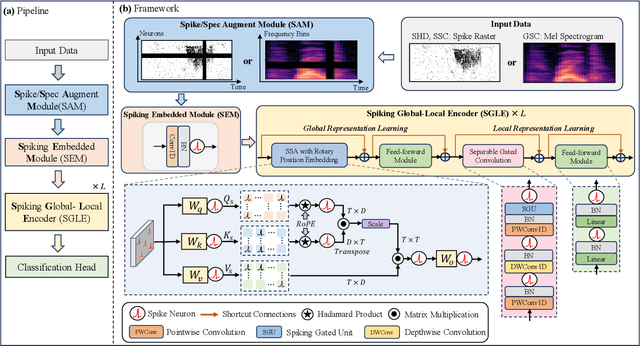
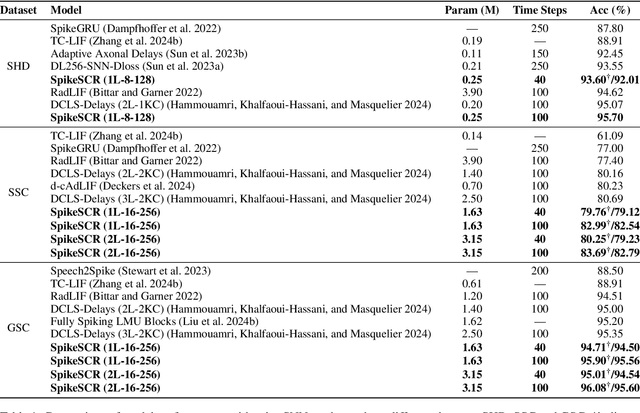
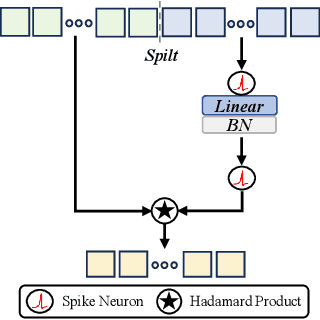

Abstract:The intrinsic dynamics and event-driven nature of spiking neural networks (SNNs) make them excel in processing temporal information by naturally utilizing embedded time sequences as time steps. Recent studies adopting this approach have demonstrated SNNs' effectiveness in speech command recognition, achieving high performance by employing large time steps for long time sequences. However, the large time steps lead to increased deployment burdens for edge computing applications. Thus, it is important to balance high performance and low energy consumption when detecting temporal patterns in edge devices. Our solution comprises two key components. 1). We propose a high-performance fully spike-driven framework termed SpikeSCR, characterized by a global-local hybrid structure for efficient representation learning, which exhibits long-term learning capabilities with extended time steps. 2). To further fully embrace low energy consumption, we propose an effective knowledge distillation method based on curriculum learning (KDCL), where valuable representations learned from the easy curriculum are progressively transferred to the hard curriculum with minor loss, striking a trade-off between power efficiency and high performance. We evaluate our method on three benchmark datasets: the Spiking Heidelberg Dataset (SHD), the Spiking Speech Commands (SSC), and the Google Speech Commands (GSC) V2. Our experimental results demonstrate that SpikeSCR outperforms current state-of-the-art (SOTA) methods across these three datasets with the same time steps. Furthermore, by executing KDCL, we reduce the number of time steps by 60% and decrease energy consumption by 54.8% while maintaining comparable performance to recent SOTA results. Therefore, this work offers valuable insights for tackling temporal processing challenges with long time sequences in edge neuromorphic computing systems.
A High Energy-Efficiency Multi-core Neuromorphic Architecture for Deep SNN Training
Dec 10, 2024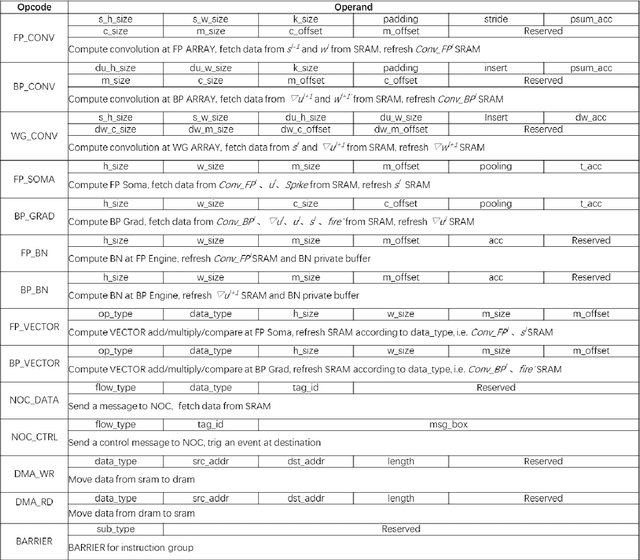
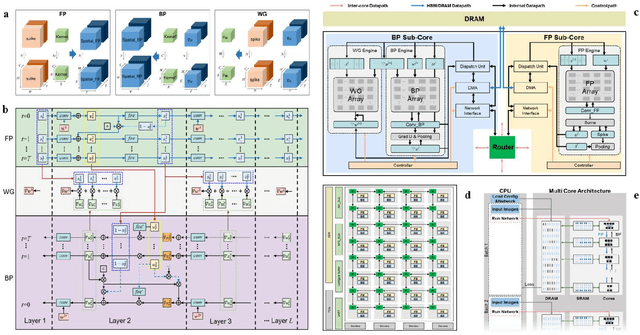
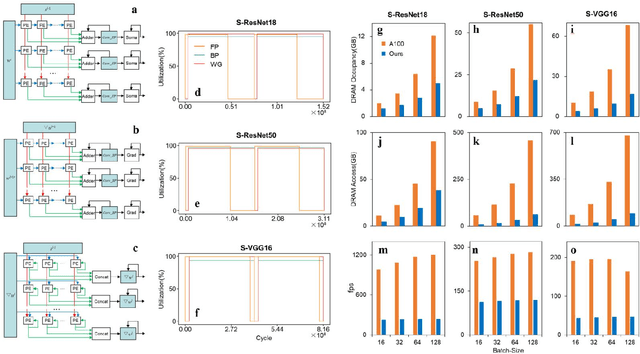
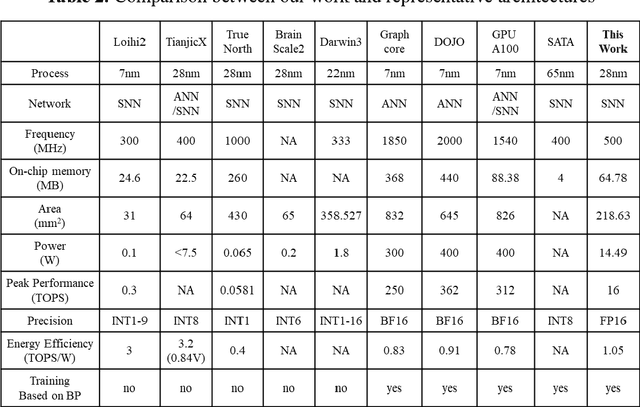
Abstract:There is a growing necessity for edge training to adapt to dynamically changing environment. Neuromorphic computing represents a significant pathway for high-efficiency intelligent computation in energy-constrained edges, but existing neuromorphic architectures lack the ability of directly training spiking neural networks (SNNs) based on backpropagation. We develop a multi-core neuromorphic architecture with Feedforward-Propagation, Back-Propagation, and Weight-Gradient engines in each core, supporting high efficient parallel computing at both the engine and core levels. It combines various data flows and sparse computation optimization by fully leveraging the sparsity in SNN training, obtaining a high energy efficiency of 1.05TFLOPS/W@ FP16 @ 28nm, 55 ~ 85% reduction of DRAM access compared to A100 GPU in SNN trainings, and a 20-core deep SNN training and a 5-worker federated learning on FPGAs. Our study develops the first multi-core neuromorphic architecture supporting the direct SNN training, facilitating the neuromorphic computing in edge-learnable applications.
Flexible and Scalable Deep Dendritic Spiking Neural Networks with Multiple Nonlinear Branching
Dec 09, 2024Abstract:Recent advances in spiking neural networks (SNNs) have a predominant focus on network architectures, while relatively little attention has been paid to the underlying neuron model. The point neuron models, a cornerstone of deep SNNs, pose a bottleneck on the network-level expressivity since they depict somatic dynamics only. In contrast, the multi-compartment models in neuroscience offer remarkable expressivity by introducing dendritic morphology and dynamics, but remain underexplored in deep learning due to their unaffordable computational cost and inflexibility. To combine the advantages of both sides for a flexible, efficient yet more powerful model, we propose the dendritic spiking neuron (DendSN) incorporating multiple dendritic branches with nonlinear dynamics. Compared to the point spiking neurons, DendSN exhibits significantly higher expressivity. DendSN's flexibility enables its seamless integration into diverse deep SNN architectures. To accelerate dendritic SNNs (DendSNNs), we parallelize dendritic state updates across time steps, and develop Triton kernels for GPU-level acceleration. As a result, we can construct large-scale DendSNNs with depth comparable to their point SNN counterparts. Next, we comprehensively evaluate DendSNNs' performance on various demanding tasks. By modulating dendritic branch strengths using a context signal, catastrophic forgetting of DendSNNs is substantially mitigated. Moreover, DendSNNs demonstrate enhanced robustness against noise and adversarial attacks compared to point SNNs, and excel in few-shot learning settings. Our work firstly demonstrates the possibility of training bio-plausible dendritic SNNs with depths and scales comparable to traditional point SNNs, and reveals superior expressivity and robustness of reduced dendritic neuron models in deep learning, thereby offering a fresh perspective on advancing neural network design.
Core Placement Optimization of Many-core Brain-Inspired Near-Storage Systems for Spiking Neural Network Training
Nov 29, 2024Abstract:With the increasing application scope of spiking neural networks (SNN), the complexity of SNN models has surged, leading to an exponential growth in demand for AI computility. As the new generation computing architecture of the neural networks, the efficiency and power consumption of distributed storage and parallel computing in the many-core near-memory computing system have attracted much attention. Among them, the mapping problem from logical cores to physical cores is one of the research hotspots. In order to improve the computing parallelism and system throughput of the many-core near-memory computing system, and to reduce power consumption, we propose a SNN training many-core deployment optimization method based on Off-policy Deterministic Actor-Critic. We utilize deep reinforcement learning as a nonlinear optimizer, treating the many-core topology as network graph features and using graph convolution to input the many-core structure into the policy network. We update the parameters of the policy network through near-end policy optimization to achieve deployment optimization of SNN models in the many-core near-memory computing architecture to reduce chip power consumption. To handle large-dimensional action spaces, we use continuous values matching the number of cores as the output of the policy network and then discretize them again to obtain new deployment schemes. Furthermore, to further balance inter-core computation latency and improve system throughput, we propose a model partitioning method with a balanced storage and computation strategy. Our method overcomes the problems such as uneven computation and storage loads between cores, and the formation of local communication hotspots, significantly reducing model training time, communication costs, and average flow load between cores in the many-core near-memory computing architecture.
DINO-X: A Unified Vision Model for Open-World Object Detection and Understanding
Nov 21, 2024



Abstract:In this paper, we introduce DINO-X, which is a unified object-centric vision model developed by IDEA Research with the best open-world object detection performance to date. DINO-X employs the same Transformer-based encoder-decoder architecture as Grounding DINO 1.5 to pursue an object-level representation for open-world object understanding. To make long-tailed object detection easy, DINO-X extends its input options to support text prompt, visual prompt, and customized prompt. With such flexible prompt options, we develop a universal object prompt to support prompt-free open-world detection, making it possible to detect anything in an image without requiring users to provide any prompt. To enhance the model's core grounding capability, we have constructed a large-scale dataset with over 100 million high-quality grounding samples, referred to as Grounding-100M, for advancing the model's open-vocabulary detection performance. Pre-training on such a large-scale grounding dataset leads to a foundational object-level representation, which enables DINO-X to integrate multiple perception heads to simultaneously support multiple object perception and understanding tasks, including detection, segmentation, pose estimation, object captioning, object-based QA, etc. Experimental results demonstrate the superior performance of DINO-X. Specifically, the DINO-X Pro model achieves 56.0 AP, 59.8 AP, and 52.4 AP on the COCO, LVIS-minival, and LVIS-val zero-shot object detection benchmarks, respectively. Notably, it scores 63.3 AP and 56.5 AP on the rare classes of LVIS-minival and LVIS-val benchmarks, both improving the previous SOTA performance by 5.8 AP. Such a result underscores its significantly improved capacity for recognizing long-tailed objects.
ETTFS: An Efficient Training Framework for Time-to-First-Spike Neuron
Oct 31, 2024Abstract:Spiking Neural Networks (SNNs) have attracted considerable attention due to their biologically inspired, event-driven nature, making them highly suitable for neuromorphic hardware. Time-to-First-Spike (TTFS) coding, where neurons fire only once during inference, offers the benefits of reduced spike counts, enhanced energy efficiency, and faster processing. However, SNNs employing TTFS coding often suffer from diminished classification accuracy. This paper presents an efficient training framework for TTFS that not only improves accuracy but also accelerates the training process. Unlike most previous approaches, we first identify two key issues limiting the performance of TTFS neurons: information disminishing and imbalanced membrane potential distribution. To address these challenges, we propose a novel initialization strategy. Additionally, we introduce a temporal weighting decoding method that aggregates temporal outputs through a weighted sum, supporting BPTT. Moreover, we re-evaluate the pooling layer in TTFS neurons and find that average pooling is better suited than max-pooling for this coding scheme. Our experimental results show that the proposed training framework leads to more stable training and significant performance improvements, achieving state-of-the-art (SOTA) results on both the MNIST and Fashion-MNIST datasets.
SVFormer: A Direct Training Spiking Transformer for Efficient Video Action Recognition
Jun 21, 2024



Abstract:Video action recognition (VAR) plays crucial roles in various domains such as surveillance, healthcare, and industrial automation, making it highly significant for the society. Consequently, it has long been a research spot in the computer vision field. As artificial neural networks (ANNs) are flourishing, convolution neural networks (CNNs), including 2D-CNNs and 3D-CNNs, as well as variants of the vision transformer (ViT), have shown impressive performance on VAR. However, they usually demand huge computational cost due to the large data volume and heavy information redundancy introduced by the temporal dimension. To address this challenge, some researchers have turned to brain-inspired spiking neural networks (SNNs), such as recurrent SNNs and ANN-converted SNNs, leveraging their inherent temporal dynamics and energy efficiency. Yet, current SNNs for VAR also encounter limitations, such as nontrivial input preprocessing, intricate network construction/training, and the need for repetitive processing of the same video clip, hindering their practical deployment. In this study, we innovatively propose the directly trained SVFormer (Spiking Video transFormer) for VAR. SVFormer integrates local feature extraction, global self-attention, and the intrinsic dynamics, sparsity, and spike-driven nature of SNNs, to efficiently and effectively extract spatio-temporal features. We evaluate SVFormer on two RGB datasets (UCF101, NTU-RGBD60) and one neuromorphic dataset (DVS128-Gesture), demonstrating comparable performance to the mainstream models in a more efficient way. Notably, SVFormer achieves a top-1 accuracy of 84.03% with ultra-low power consumption (21 mJ/video) on UCF101, which is state-of-the-art among directly trained deep SNNs, showcasing significant advantages over prior models.
 Add to Chrome
Add to Chrome Add to Firefox
Add to Firefox Add to Edge
Add to Edge